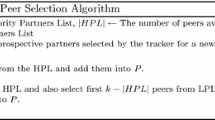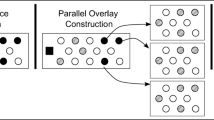Abstract
Despite the large number of works devoted to understand P2P live streaming applications, most of them put forth so far rely on characterizing the static view of these systems. In this work, we characterize the SopCast, one of the most important P2P live streaming applications. We focus on its dynamics behavior as well as on the community formation phenomena. Our results show that SopCast presents a low overlay topology diameter and low end-to-end shortest path. In fact, diameter is smaller than 6 hops in almost 90 % of the observation time. More than 96 % of peers’ end-to-end connections present only 3 hops. These values combined may lead to low latencies and a fast streaming diffusion. Second, we show that communities in SopCast are well defined by the streaming data exchange process. Moreover, the SopCast protocol does not group peers according to their Autonomous System. In fact, the probability that a community contains 50 % of its members belonging to the same AS (when we observe the largest AS of our experiments) is lower then 10 %. Peers exchange more data with partners belonging to the same community instead of peers inside the same AS. For the largest AS we have, less than 18 % of peer traffic has been exchanged with another AS partners. Finally, our analysis provides important information to support the future design of more efficient P2P live streaming systems and new protocols that exploit communities’ relationships.




























Similar content being viewed by others
Notes
According to Google Trends, SopCast receives a larger number of searches than PPLive and PPStream. The availability of a Linux implementation of SopCast was also a motivation to characterize this particular application.
The total number of snapshots is not equal to 3600s because we do not take into account the transient state of the system. We discard the initial 5-minute of each experiment.
Probability Density Functions are: Weibull: \({p_{X}(x)} = \alpha \beta {x}^{\beta -1} {e}^{-\alpha {x}^{\beta }}\) \(I_{(1,\infty )}(x)\), Lognormal: \(p_{X}(x) = \frac {1}{x \sigma \sqrt {2\pi }} e^{\frac {-(ln(x)-\mu )^{2}}{2\sigma ^{2}}}\), Exponential: p X (x)=λ e −λx, Gamma: \(p_{X}(x) = \frac {\beta ^{\alpha }}{\Gamma (\alpha )}x^{\alpha -1}e^{\beta x}\) and Normal: \(P(x) = \frac {1}{{\sigma \sqrt {2\pi } }}e^{{{ - \left ({x-\mu }\right )^{2}} {\left /{{{-\left ({x-\mu }\right )^{2}} {2\sigma ^{2} }}} \right . \kern -\nulldelimiterspace } {2\sigma ^{2} }}}\)
The clustering coefficient for random graphs is given by \(\mathcal {C}_{random} = \frac {<k>}{|\mathcal {V}|}\), with <k> the mean degree and \(|\mathcal {V}|\) the total number of nodes
References
Basu P, Bar-Noy A, Ramanathan R, Johnson MP (2010) Modeling and analysis of time-varying graphs. Published on arXiv:1012.0260
Bermudez I, Mellia M, Meo M (2011) Investigating overlay topologies and dynamics of P2P-TV systems: the Case of SopCast. IEEE J Sel Area Comm 29(9):1863–1871
Borges A, Gomes P, Nacif J, Mantini R, Almeida JM, Campos S (2012) Characterizing sopCast client behavior. Comput Commun 35(8):1004–1016
Chun B, Culler D, Roscoe T, Bavier A, Peterson L, Wawrzoniak M, Bowman M (2003) PlanetLab: An overlay testbed for broad-coverage services. ACM SIGCOMM Comput Commun Rev 33(3)
Ciullo D, da Rocha AG, Horvath A, Leonardi E, Mellia M, Rossia D, Telek M, Veglia P (2010) Network awareness of P2P live streaming applications: A measurement study. IEEE T Multimedia 12(1):54–63
Clauset A, Newman MEJ, Moore C (2004) Finding community structure in very large networks. Phys Rev E 70(6):066111
Fallica B, Lu Y, Kuipers F, Kooij R, Mieghem PV (2008) On the quality of experience of SopCast. In: Proceedings of the Int’l conference on next generation mobile applications, services and technologies, pp 501–506
Gonçalves G, Guimarães A, Cunha I, Vieira A, Almeida J (2012) Using centrality metrics to predict peer cooperation in live streaming applications. In: Proceedings of the 11th International IFIP Networking Conference (NETWORKING’12)
Gonçalves KC, Vieira AB, Almeida J, da Silva APC, Marques-Neto H, Campos SVA (2012) Characterizing dynamic properties of the SopCast overlay network. In: Proc. of the IEEE 20th Euromicro International Conference on Parallel, Distributed and Network-based Processing (PDP)
Hartigan JA, Wong MA (1979) Algorithm as 136: A k-means clustering algorithm. J R Stat Soc: Ser C: Appl Stat 28(1):100–108. http://www.jstor.org/stable/2346830
Hei X, Liang C, Liang J, Liu Y, Ross KW (2007) A Measurement Study of a Large-Scale P2P IPTV System. IEEE T Multimedia 9(8):1672–1687
Huang Y, Fu TZJ, Chiu D-M, Lui JCS, Huang C (2008) Challenges, Design and Analysis of a Large-Scale P2P-VoD System. In: Proceedings of the ACM SIGCOMM Conference on Data Communication
Li B, Keung GY, Xie S, Liu F, Sun Y, Yin H (2008) An empirical study of flash crowd dynamics in a p2p-based live video streaming system. In: Global telecommunications conference, 2008. IEEE globecom 2008. IEEE, pp 1–5
Li R, Gao G, Xiao W, Xu Z (2011) Measurement study on pplive based on channel popularity. In: Hayes JF, Lambadaris I, Yu FR, Nikolaidis I, Viniotis Y (eds) CNSR. IEEE Computer Society, pp 18–25
Marfia G, Sentivelli A, Tewari S, Gerla M, Kleinrock L (2007) Will IPTV Ride the Peer-to-Peer Stream? IEEE Communications Magazine Special Issue on Peer-to-Peer Streaming
Newman MEJ (2003) The structure and function of complex networks. SIAM Rev:167–256
Newman MEJ (2004) Fast algorithm for detecting community structure in networks. Phys Rev E 69(6)
The Network Time Protocol. www.ntp.org/ (last accessed at August 2014)
Pathak A, Pucha H, Zhang Y, Hu YC, Mao ZM (2008) In: Claypool M, Uhlig S (eds) Pam, Lecture Notes in Computer Science, vol 4979. Springer, pp 182–191
Sandvine (2012) The Global Internet Phenomena Report: 2H 2012– www.sandvine.com
Silverston T, Fourmaux O, Botta A, Dainotti A, Pescapé A, Ventre G, Salamatian K (2009) Traffic analysis of peer-to-peer IPTV communities. Comput Netw 53(4):470–484
Silverston T, Fourmaux O, Salamatian K, Cho K (2010) On Fairness and Locality in P2P-TV Through Large-Scale Measurement Experiment. In: Proceedings of the IEEE Global Telecommunications Conference (GLOBECOM)
Silverston T, Fourmaux O (2007) Measuring P2P IPTV Systems. In: Proceedings of the ACM network and operating system support for digital audio and video - nossdav
Spoto S, Gaeta R, Grangetto M, Sereno M (2009) Analysis of pplive through active and passive measurements. In: Proc. of the 2009 IEEE international symposium on parallel & distributed processing
Tang S, Lu Y, Hernández JM, Kuipers F, Mieghem P (2009) Topology Dynamics in a P2PTV Network. In: Proc. of the 8th International IFIP-TC 6 Networking Conference, NETWORKING’09
Tian J, Dai Y (2007) Understanding the dynamic of peer-to-peer systems. In: Proceedings of the 6th International Workshop on Peer-to-Peer Systems (IPTPS)
Vieira AB, da Silva APC, Henrique F, Goncalves G, de Carvalho Gomes P (2013) Sopcast p2p live streaming: Live session traces and analysis. In: Proceedings of the 4th ACM multimedia systems conference
Vu L, Gupta I, Liang J, Nahrstedt K (2007) Measurement and modeling a large-scale overlay for multimedia streaming. In: Proceedings of the Fourth International Conference on Heterogeneous Networking for Quality, Reliability, Security and Robustness (QShine)
Wu C, Li B, Zhao S (2008) Exploring large-scale peer-to-peer live streaming topologies. ACM Trans Multimed Comput Commun Appl (TOMCCAP) 4(3):1–23
Zhang Y, Xiao C, Zhang H (2010) Analysis of session sequences of stable peers in P2P systems. In: Proceedings of the 3rd IEEE International Conference on Broadband Network and Multimedia Technology (IC-BNMT)
Acknowledgments
This work was partially supported by the Brazilian Agencies FAPEMIG, CAPES and CNPq.
Author information
Authors and Affiliations
Corresponding author
Rights and permissions
About this article
Cite this article
Ferreira, F.H., da Silva, A.P.C. & Vieira, A.B. Characterizing peers communities and dynamics in a P2P live streaming system. Peer-to-Peer Netw. Appl. 9, 1–15 (2016). https://doi.org/10.1007/s12083-014-0307-x
Received:
Accepted:
Published:
Issue Date:
DOI: https://doi.org/10.1007/s12083-014-0307-x




